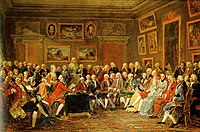
Photo from wikipedia
Abstract The spatial growth of German cities in the years of upheaval in the nineteenth century has been, and remains, the subject of intense historical research. However, the origins of… Click to show full abstract
Abstract The spatial growth of German cities in the years of upheaval in the nineteenth century has been, and remains, the subject of intense historical research. However, the origins of the socio-economic processes underlying these transformations actually predate the epochal transition into the modern era. This article deals critically with the popular conception of a ‘town–country dichotomy’ by comparing, on an empirical basis, urban, semi-urban and rural settlements in a sub-region of the north-west of Germany in the mid-eighteenth century. With the aid of a Geographical Information System (GIS), the cartographic and serial material of the ‘Brunswick Land Survey’ is evaluated in terms of its relevance to a socio-topographic comparison of the spatial micro-structures of the three respective settlement segments. The comparison focuses on the general morphology of the settlement segments, the conditions accompanying the growth of the settlements and the spatial structures of the agricultural activities pursued. In addition, it identifies the factors which led to the erosion of differences between town and country.
Journal Title: Urban History
Year Published: 2020
Link to full text (if available)
Share on Social Media: Sign Up to like & get
recommendations!